
PREV ARTICLE
NEXT ARTICLE
FULL ISSUE
PREV FULL ISSUE
SELECTIONS FROM STACK'S BOWERS JUNE 2017 SALESHere are several items that caught my eye in the upcoming Stacks Bowers June 2017 Baltimore auction. Many of these are from the Dave Bowers and Steve Tanenbaum Collections, and more
rare than an 1804 Dollar or 1913 Liberty Nickel. -Editor
 Lot 9024: Unique H. Herring of Fair Mount Token
 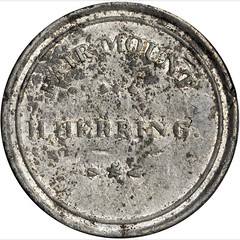 Maryland--Baltimore. 1834 H. Herring. HT-139, Low-173. Rarity-9. White Metal. Plain Edge. 35 mm. VF-20. Unique! This token is a landmark among Hard Times issues-one of the most famous and one of only a few with this status! Over a long period of decades, great collections have been formed and dispersed without having an example. Donald Miller, Stephen L. Tanenbaum, Donald Partrick, and other great collectors in the series never had a chance to own this. The term "once in a lifetime opportunity" has its very definition here! To quote from Lyman Low, the master of the Hard Times token series, who wrote this in 1906 in the supplement to his Hard Times Tokens book: "...this token first came to my notice about four years ago, and from the best investigation I have been able to make it was unknown to collectors until then; I have never learned of its duplicate. Not withstanding the fact that collectors of store-cards and tokens have been always with us, and the work in their special lines has been unceasing, this interesting piece seems to have evaded their watchful eyes. When we remember that such cabinets as those of Messrs. Groh, Levick, Geo. B. Mason, Benjamin Betts, Benjamin Tilton, Dr. James, Dr. Wright and others, contained many precious cards, the record prices of which in various sales show that they have brought from $10 to $50, it is remarkable that this piece should have escaped the notice of them all for nearly seventy years. The indefatigable labor and zeal of Mr. Duffield has traced this token to Baltimore, though at first light it was his opinion, shared by Dr. Wright and myself, that it originated in Philadelphia. "Mr. Henning (sic) was the proprietor of a hotel, promenade and pleasure ground at Fair Mount which he appears to have given the name. Its site was formerly known as Hampstead Hill, in the eastern part of the city of Baltimore. His advertisement appears in the Baltimore American and Commercial Advertiser in May, 1834, when he announced he was erecting at great expense, a large and elegant House etc. The resort was subsequently known as Fair Mount Gardens. His name is found in the Baltimore Directories from 1834 to 1835. Just what purpose this piece served, it is very difficult to assert at this remote time, but the fact that it is dated would lead one to believe it was used in some detail of his conduct of the place, during the first year of its existence, and not as an advertising venture." Not a beautiful piece, but as rare as it gets in American numimsmatics. -Editor
To read the complete lot description, see:
Lot 950: The Earliest American Dollar-Denominated Token
 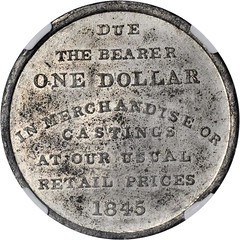 Extremely Rare Johnson Himrod & Co. $1.00 Token
Pennsylvania--Erie. 1845 Johnson Himrod & Co. Miller-Pa 3. White Metal. 38 mm. MS-61 (NGC). This is an extreme rarity with an important place in the history of American tokens as the very first token ever struck with a one dollar denomination. An Extremely Fine specimen in our (Stack's) Dice-Hicks sale realized $8,050. Known only in white metal, the "copper-plated white metal" piece illustrated in Rulau is an electrotype. This ranks among the finest known. The collecting of early tokens and medals has become a very dynamic part of numismatics in recent years. In the early 20th century various issues were very popular -- much more so than, for example, collecting Morgan dollars by date and mint. Starting in a large way in the 1930s with popular albums and pages available from Wayte Raymond and Whitman, date and mintmark collecting came to the fore. Today, this remains the focus of nearly all collectors -- well over a million who are serious and millions more who are casual in their interest. It could not be otherwise, for among early tokens and medals there are not enough in existence to satisfy a large demand. For the typical "common" Hard Times token, Civil War token, or other early American store card, often the population is fewer than 100 pieces. A wordy piece, but typical for the time period. Another great rarity. -Editor
To read the complete lot description, see:
Lot 9111: Martin Ibert Civil War Token
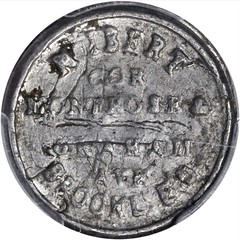  New York--Brooklyn. Undated (1861-1865) Martin Ibert. Fuld-095C-1g. Rarity-9. Lead. Plain Edge. 19 mm. EF Details--Planchet Flaw (PCGS). This is a major rarity in this series as there are only two known examples of Fuld-95C-1g, the only type attributed to this merchant. At the time Brooklyn was a separate city, but today it is incorporated as a borough of New York City. Collecting NYC and related tokens has long been a specialty, with Wayte Raymond, for one, spending years building his holdings. Martin Ibert was born in Baden, Germany in 1861, emigrating from that country to the United States in 1847 with his brother Albert. He became a clerk in Henry Zimmer's store in Brooklyn, and then worked for A. Saul before opening his own business dealing in flour at the corner of Leonard Street and Montrose Avenue. He later moved his business to Montrose and Graham avenues, as depicted on this token, and in 1889 left the flour business to start a brewing company. This is the plate token for the obverse die in the third edition of U.S. Civil War Store Cards, the research and graphics triumph of the Civil War Token Society. Another rarirty that I've never seen before. -Editor
To read the complete lot description, see:
Lot 9116: 1863 Atlantic Garden Token
 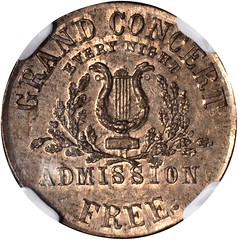 Fuld NY-630A-1do Atlantic Garden
New York--New York. 1863 Atlantic Garden. Fuld-630A-1do. Rarity-9. Copper-Nickel. Plain Edge. 20 mm--Overstruck on an 1859 Indian Cent--MS-65 (NGC). The Bowery in lower Manhattan was the center for culture-high as in theaters, low as in gambling dens and ladies of the night. Somewhere in between was the vast Atlantic Garden beer hall at 150 Bowery, memorialized on Civil War tokens and famous for two huge orchestrions or automatic orchestras-the first installed in the 1860s and its successor brought after being a sensation at the World's Columbian Exposition in 1893. The history of the Atlantic Garden is well documented by Henry B. Dawson (see Historical Magazine, July 1867) and Edgar H. Adams (see The Numismatist, September 1911). Dave Bowers has also written extensively about this unique establishment. Edgar Adams said in part: "Atlantic Garden, one of the oldest of New York's amusement places, is to be torn down this month. For over half a century it has been conducted as a German family resort, where one could enjoy good music and, incidentally, good beer, and other refreshments. Here held forth a famous lady orchestra which many New Yorkers and out-of-town visitors well remember. The Garden was built on the site of the Bull's Head Tavern, which for a time served as Washington's headquarters during Revolutionary days." Who would want to miss the GRAND CONCERT / EVERY NIGHT / ADMISSION / FREE ? Curious, I visited the address on Google Maps and apparently today you'll find the Jing Fong
Restaurant in Chinatown. of course, over the decades city streets can get renamed and renumbered, so some work would be required to verify that. -Editor
To read the complete lot description, see:
Now we move to the U.S. coin portion of the sale. -Editor
Lot 11606: 1872 Pattern Amazonian Eagle
 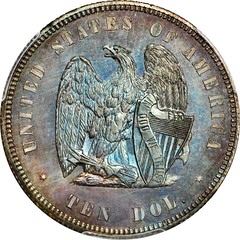 Fabled 1872 Pattern Amazonian Eagle
1872 Pattern Amazonian Eagle. Judd-1246, Pollock-1388. Rarity-7-. Copper. Reeded Edge. Proof-64 BN (PCGS). CAC. Obv: William Barber's celebrated Amazonian design with a bust of Liberty facing left, 13 stars around the border, and the date 1872 below. Liberty is wearing a Phrygian cap inscribed LIBERTY. Rev: An eagle with spread wings clutches a group of three arrows in its right talon and supports a shield with its left talon. A scroll crossing the shield is inscribed with the motto IN GOD WE TRUST. The legend UNITED STATES OF AMERICA is above and the denomination TEN DOL. is below. This beautiful near-Gem is vividly toned in a blend of steel-blue and copper-rose colors. Fully struck in all but a couple of isolated areas, both sides are smooth and attractive with a lively satin to semi-reflective finish. This is one of the most famous and eagerly sought designs among U.S. pattern coinage. Great piece with lovely toning. Patterns are a delight to collect. These "also-ran" designs the didn't make the final cut are every bit as nice as the ones that became
familiar as circulating coins, and often stunning in execution. I particularly like the obverse and Miss Liberty's long hair. -Editor
To read the complete lot description, see:
Lot 11614: Miners' Bank $10 Gold
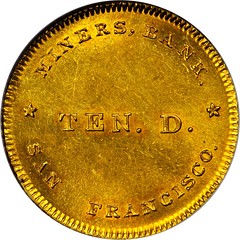 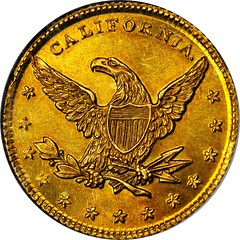 Undated (1849) Miners' Bank $10 Gold. K-1. Rarity-6. Copper Alloy, Plain Border. MS-65 (NGC). The firm of Wright & Co., exchange brokers, was located at the corner of Washington and Kearny streets, Portsmouth Square, San Francisco, early in September 1849. On August 7 the firm requested permission from local authorities to coin $5 and $10 gold coins, declaring they would be worth as much as Federal issues. Authorization was not granted. In November, Wright & Co. reorganized. Composing the new company were Stephen A. Wright, John Thompson, Samuel W. Haight, and J.C.L. Wadsworth. Known as the Miners' Bank (or Miners/Miner's-punctuation varied), the outfit was housed in a wooden frame structure for which the incredible sum of $75,000 rent per year was paid. It is believed that the $10 coins were produced in the autumn, apparently before the November 1849 reorganization was completed, for William P. Hoit, assayer of the New Orleans Mint, reported on December 13, 1849, that he had assayed a Miners' Bank $10 nearly two months earlier, and that he had found it to be worth only $9.65. Alta California reported this on April 11, 1850: "The issue of the Miners' Bank is a drug on the market. Brokers refuse to touch it at less than 20 percent discount.…" On December 14, 1850, the Miners Bank dissolved. As the Miners Bank $10 pieces no longer circulated at par, the pieces in the hands of the public went to bullion dealers at a discount and were melted. Within a few years they were rare. Provenance: From Numismatic Gallery's (Abe Kosoff and Abner Kreisberg) sale of the "Memorable Collection" (i.e., J.F. Shapiro, a.k.a. J.F. Bell), March 1948, lot 968; RARCOA's session of Auction '82, August 1982, lot 989; our (Stack's) sale of the Archangel Collection, November 2006, lot 1076. The catalog description gushes about the condition of this particular piece, which is indeed likely the finest in existence. Beautiful, despite the plain-Jane obverse design.
-Editor
To read the complete lot description, see:
Lot 11624: 1860 Mormon $5 Uniface Obverse Restrike
  1860 Mormon $5. Uniface Obverse Restrike. K-8. Rarity-7. Copper. Plain Edge. MS-64 RB (NGC). Abundant mint red luster glows amid brown, speck-free surfaces on this near Gem survivor of the unused die of 1860 Mormon $5s. The actual die that struck the 1860 issues in gold had only a larger and more upright reclining lion, whereas this obverse die features the nearly fully reclining lion at the foot of a trio of stylized mountain peaks, undoubtedly representing Salt Lake City at the foot of the Rocky Mountains. It is thought that this and the other uniface Mormon restrikes in copper were made circa 1898 for promotional use during the commemoration of the 50th anniversary of the Mormons' arrival in what became Salt Lake City. This particular pattern is popular not only for its unused design, but also for its use of the short-lived Deseret alphabet to deliver a phonetic rendering of the phrase "Holiness to the Lord". This "restrike" has it all-high quality, rarity, pedigree, a charming unadopted design, and the rare numismatic usage of the Deseret alphabet. Provenance: From Kagin's circa 2008 Fixed Price List of the Robert Bass Collection of Pioneer Patterns, lot 128. The Mormon Deseret alphabet is the most curious part of this piece. -Editor
To read the complete lot description, see:
Lot 11632: Confederate Half Dollar Scott Restrike
  "1861" (1879) Confederate Half Dollar. Scott Restrike. Breen-8002. AU-55 (NGC). A richly toned steel gray example with sharp detail to much of the reverse design. Seized by Louisiana when that state seceded from the Union in 1861, the New Orleans Mint eventually passed under the control of the Confederate States of America. After that happened, Southern authorities made an attempt at coinage that displayed a design distinct to the new Confederacy. Accordingly, four half dollars were struck combining the familiar Liberty Seated motif of Union coinage with a new reverse design that includes, among other elements, the legend CONFEDERATE STATES OF AMERICA. All four of these coins, as well as the reverse die, were retained by Chief Coiner of the New Orleans Mint Dr. B.F. Taylor. The die was eventually obtained by E.B. Mason, Jr. of Philadelphia in 1879 and sold to John Walter Scott. Scott and his partner decided to profit from their ownership of the original CSA reverse die by striking and selling a small number of restrikes of the very rare 1861 Confederate half dollar. In order to test the die and determine its suitability for coinage, Scott at first struck 500 tokens using a new obverse die the inscriptions of which provide some information about the original 1861 CSA halves. He then proceeded to prepare the actual restrikes. To do so Scott obtained 500 original 1861-O Liberty Seated half dollars, "drilled off" their reverses and restruck that side using the Confederate reverse die. This process caused more-or-less loss of detail to the obverse design, as evident on the present example. For those of us who will never own one of the originals, these restrikes are a great substitute. -Editor
To read the complete lot description, see:
 Wayne Homren, Editor The Numismatic Bibliomania Society is a non-profit organization promoting numismatic literature. See our web site at coinbooks.org. To submit items for publication in The E-Sylum, write to the Editor at this address: whomren@gmail.com To subscribe go to: https://my.binhost.com/lists/listinfo/esylum All Rights Reserved. NBS Home Page Contact the NBS webmaster 
|